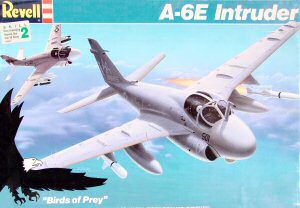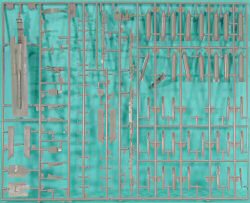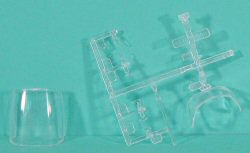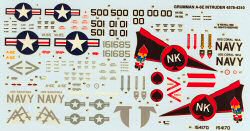
Revell 1/48 A-6E Intruder Kit First Look
By Michael Benolkin
| Date of Review | April 2007 | Manufacturer | Revell |
|---|---|---|---|
| Subject | A-6E Intruder | Scale | 1/48 |
| Kit Number | 4578 | Primary Media | Styrene |
| Pros | Best A-6 in any scale | Cons | |
| Skill Level | Basic | MSRP (USD) | Out of Production |
First Look
 |
 |
 |
 |
 |
 |
The A-6 Intruder was one of many aircraft off the Grumman production lines that was designed with the pointed end of the aircraft on the rear. The A-6, like the S-2, E-1, E-2, C-1, C-2, and others, were all purpose-built to meet the requirements of the mission. In the case of the A-6, the US Navy wanted an all-weather, carrier-based, precision attack platform. Initially developed in the early 1960s, the A-6A was a platform for the next generation of precision attack avionics - the Digital Integrated Attack/Navigation Equipment (DIANE) with required quite a bit of space for the black boxes and a sizable radome for the radar antennas.
The aircraft was powered by a pair of J52 turbojets, the same engine used by the A-4 Skyhawk. This made engine logistics at sea much easier.
The A-6A had early teething problems with its new avionics making its introduction into service troublesome, but not unique in the history of sophisticated aircraft. As the bugs were worked out, the A-6A would provide the best targeting information, even in bad weather, which would lead to A-6s leading multi-service air strikes over Vietnam.
The A-6B consisted of 19 A-models that were modified into Wild Weasels during Vietnam to parallel the Air Force's new mission and provide a Navy capability to suppress the new enemy SAM sites.
The A-6C consisted of 12 A-models that were modified with TRIM pod with FLIR and Black Crow sensors to interdict supply lines along the infamous 'Ho Chi Mihn Trail'.
The KA-6D was designed as a dedicated air refueling platform to top off aircraft heading off on air strikes as well as refuel returning aircraft so they can wait their turn in the marshal stack to return aboard the carrier.
The A-6E was a new-build airframe (though a number of A/B/C models were also upgraded to the E configuration) that incorporated new radars, updated avionics, and greater mission capabilities. In 1979, the A-6E fleet was again updated with the Target Recognition and Attack Multi-Sensor (TRAM) turret under the nose.
The A-6F was to be a modernized airframe replacing the old J52 engines with non-afterburning F404 turbofans (the same core engine in the F/A-18), and new radars and avionics. While five development aircraft were completed in the concept phase of the program, the Navy opted to cancel the program in favor of the upcoming A-12 Avenger II. When Grumman offered a lower-cost alternative, the A-6G, which would encompass the new avionics but retain the original engines, the Navy again declined. This left the Navy with a problem when the A-12 program defaulted a few years later.
When Revell released this kit in 1988, it was a significant milestone in kit development. This was not your usual Revell kit as this release had all the hallmarks of internal and external detailing usually found in Monogram kits. Of course the two companies were in the midst of becoming one company, but that is another story.
What is impressive about this model is its size. Revell and Monogram were never shy about making large kits, and this is certainly one of them! The detailing is classic Revell-Monogram - fine details molded on the surfaces but still back in the days of raised detailing.
The cockpit is nicely detailed and is configured for the TRAM version of the aircraft. With a little work, you can backdate the aircraft to a pre-TRAM E-model or even further if you'd like.
The kit's intakes are reasonably done, though the ducts are noticeably shallow. There are aftermarket seamless intakes available to render deeper intake ducts as well as tweak up the detail and appearance in this area.
The kit offers both the early solid fuselage speed brakes as well as the later TRAM-added perforated speed brakes.
The wings are assembled with a typical Revell-Monogram well-engineered mechanical fit so you can safely handle the aircraft by the wing without worry of a wing dropping off. Should you want to pose the aircraft with the wings folded, Paragon developed a set of wing fold details for this kit. I don't believe they are back in production, but they can still be had at hobby flea markets.
The TRAM turret is separately molded so you can opt to backdate your Intruder without having any holes or scars to fill.
The kit provides the following external stores options:
- Centerline external fuel tank
- Wing external fuel tanks (2)
- AGM-84 Harpoon x 2
- Multiple Ejector Racks x 2
- Mk.82 Snakeye x 12
- Cluster bombs x 8
Markings are provided for two aircraft:
- A-6E, 154170, NK/500, VA-196, CAG, USS Coral Sea
- A-6E(TRAM), 161685, AA/501, VA-85, USS Saratoga
The kit decals, as you can see, are a bit out of register, but that's okay, the clear film has yellowed with age and will need replacing with aftermarket decals anyway.
This kit remains the best Intruder kit in any scale to date. Granted that Trumpeter is supposed to release a 1/32 version of this aircraft, it will remain to be seen whether it can wrest the title of 'best in any scale' away from this still excellent model.







